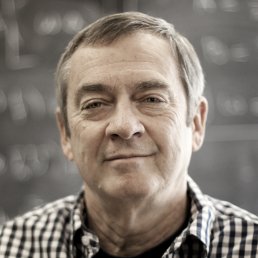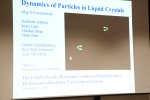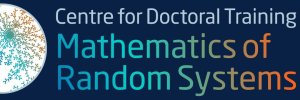The Brooke Benjamin Lecture in Fluid Dynamics
The Seventeenth Brooke Benjamin Lecture 2024
The Elusive Singularity
I will describe the open problems of singularity formation in incompressible fluids. I will discuss a list of related models, some results, and some more open problems.
Date: Monday, 11 November 2024
Time: 5pm GMT
Location: Lecture Theatre 1, Mathematical Institute
Speaker: Professor Peter Constantin
 Peter Constantin is the John von Neumann Professor of Mathematics and Applied and Computational Mathematics at Princeton University. Peter Constantin received his B.A and M.A. summa cum laude from the University of Bucharest, Faculty of Mathematics and Mechanics. He obtained his Ph.D. from The Hebrew University of Jerusalem under the direction of Shmuel Agmon.
Peter Constantin is the John von Neumann Professor of Mathematics and Applied and Computational Mathematics at Princeton University. Peter Constantin received his B.A and M.A. summa cum laude from the University of Bucharest, Faculty of Mathematics and Mechanics. He obtained his Ph.D. from The Hebrew University of Jerusalem under the direction of Shmuel Agmon.
Constantin’s work is focused on the analysis of PDE and nonlocal models arising in statistical and nonlinear physics. Constantin worked on scattering for Schr¨odinger operators, on finite dimensional aspects of the dynamics of Navier-Stokes equations, on blow up for models of Euler equations. He introduced active scalars, and, with Jean-Claude Saut, local smoothing for general dispersive PDE. Constantin worked on singularity formation in fluid interfaces, on turbulence shell models, on upper bounds for turbulent transport, on the inviscid limit, on stochastic representation of Navier-Stokes equations, on the Onsager conjecture. He worked on critical nonlocal dissipative equations, on complex fluids, and on ionic diffusion in fluids.
Constantin has advised thirteen graduate students in mathematics, and served in the committee of seven graduate students in physics. He mentored twenty-five postdoctoral associates.
Constantin served as Chair of the Mathematics Department of the University of Chicago and as the Director of the Program in Applied and Computational Mathematics at Princeton University.
Constantin is a Fellow of the Institute of Physics, a SIAM Fellow, and Inaugural Fellow of the American Mathematical Society, a Fellow of the American Academy of Arts and Sciences and a member of the National Academy of Sciences.
Organisers:
About Thomas Brooke Benjamin (1929-1995)
Professor Thomas Brooke Benjamin, born 15 April 1929, developed an aptitude for science at an early age through his avid interest in constructing radio sets. This continued throughout his childhood until his admission to Liverpool University to study for a BEng in 1947.
After graduating from Liverpool with First Class Honours in 1950, Benjamin was granted a Rotary foundation fellowship to study electronics at Yale University, where he gained an MEng in 1952. Following a period of study in the United States, he entered King's College, Cambridge in 1952 where he devised ingenious and accurate new experiments to study cavitation in fluid flow. In 1955, he was elected a Fellow of King's College, and in 1958 was appointed Assistant Director of research in both the engineering department and in the department of applied mathematics and theoretical physics (DAMTP). It was here that Benjamin developed further research into fluid dynamics by converting the departmental basement into a laboratory dedicated to research solely in this field. Whilst at Cambridge, Benjamin made several key contributions to the study of fluid dynamics, most notably in the area of instability in varying kinds of fluid motion. Benjamin also prompted further study of the French school of nonlinear analysis and its unquestionable influence upon certain fluid instabilities.
In 1970, Benjamin was appointed to a professorship at the University of Essex, where he set up the Fluid Mechanics Research Institute. The Institute was incredibly successful with over ninety research reports published during Benjamin's tenure.
After a successful period at Essex, Benjamin was appointed to the Sedleian chair of natural philosophy at Oxford, with a fellowship at Queen's College in 1978, which he held until his death in 1995. He was also appointed as adjunct professor at Pennsylvania State University which he made frequent visits to.
Throughout his career Benjamin was awarded a vast array of honours including the Lewis F. Moody award from the American Society of Civil Engineers in 1966, election to the Royal Society of London (1966), the William Hopkins prize of the Cambridge Philosophical Society in 1969 and in 1993 he was elected a foreign member of the French Academy of Sciences. He received honorary degrees from the universities of Liverpool, Bath, and Brunel.
Perhaps the most eloquent tribute to Brooke Benjamin is given by M. S. Longuet-Higgins in the Oxford Dictionary of National Biography:
Benjamin, known to his friends as Brooke, was tall, modest, and always polite. Among his colleagues he inspired great admiration, affection, and loyalty. With a quiet sense of humour, he was inwardly sensitive and imaginative. He was justifiably proud that despite taking a leading part in many activities he made no known enemies.
Benjamin died on the 16 August 1995 and is survived by his wife, Natalia, their daughter, Victoria, and children of his first and second marriage.
Past Lectures
Sixteenth Brooke Benjamin Lecture - Tuesday, 21 November 2023
Professor James Sethian, Professor of Mathematics and Head of the Mathematics Department of the Lawrence Berkeley National Laboratory, University of California at Berkeley
Advances in Advancing Interfaces: The Mathematics of Manufacturing of Industrial Foams, Fluidic Devices, and Automobile Painting
Complex dynamics underlying industrial manufacturing depend in part on multiphase multiphysics, in which fluids and materials interact across orders of magnitude variations in time and space. In this talk, we will discuss the development and application of a host of numerical methods for these problems, including Level Set Methods, Voronoi Implicit Interface Methods, implicit adaptive representations, and multiphase discontinuous Galerkin Methods. Applications for industrial problems will include modeling how foams evolve, how electro-fluid jetting devices work, and the physics and dynamics of rotary bell spray painting across the automotive industry.
Fifteenth Brooke Benjamin Lecture - Monday 14th November 2022
Prof. Laure Saint-Raymond Professor of Mathematics, Institut des Hautes Études Scientifiques
Fluctuating Hydrodynamics: how noise emerges from microscopic instabilities
In this talk, Saint-Raymond showed that (linear) fluctuating hydrodynamics can be derived in the low-density limit from deterministic systems of particles. The apparition of dynamical noise can be related to the concept of "spontaneous stochasticity".
Laure Saint-Raymond is a French mathematician, and a professor of mathematics at Institut des Hautes Études Scientifiques (IHES). She was previously a professor at École Normale Supérieure de Lyon. Laure Saint-Raymond’s work focuses mainly on the asymptotic analysis of systems of partial differential equations, in particular those governing the dynamics of gases, plasmas, and fluids.
This event was sponsored by The Oxford Centre for Nonlinear Partial Differential Equations, EPSRC Centre for Doctoral Training in Partial Differential Equations, EPSRC Centre for Doctoral Training in Mathematics of Random Systems, and Mathematical Institute, University of Oxford.
Fourteenth Brooke Benjamin Lecture - 5pm Friday 5 November 2021
Prof. Beverley J. McKeon, Graduate Aerospace Laboratories, California Institute of Technology
What’s in a mean? Some implications of self-similarity in wall turbulence
The financial and environmental cost of turbulence is staggering: manage to quell turbulence in the thin boundary layers on the surface of a commercial airliner and you could almost halve the total aerodynamic drag, dramatically cutting fuel burn, emissions and cost of operation. Yet systems-level tools to model scale interactions or control turbulence remain relatively under-developed. Resolvent analysis for turbulent flow provides a simple, but rigorous, approach by which to deconstruct the full turbulence field into a linear combination of modes which interact through the nonlinear term.
In this talk, some commonalities and differences between observations of self-similar behavior in wall turbulence in experiments, in simulation, and in the Navier-Stokes equations are identified. Model results obtained using resolvent analysis and desktop computing power are compared with direct numerical simulation and complex experiments, highlighting the utility of resolvent analysis as a modeling tool, and the dramatic reduction in complexity associated with sparsity and low-rank behavior in the resolvent, attributable to the information encoded in the (turbulent) mean field.
The support of the U.S. Air Force Office of Scientific Research under grant FA 9550-16-1-0361 and the U.S. Office of Naval Research under grant N00014-17-1-2307 is gratefully acknowledged.
Beverley McKeon is Theodore von Karman Professor of Aeronautics at the Graduate Aerospace Laboratories at Caltech (GALCIT). Her research interests include interdisciplinary approaches to manipulation of boundary layer flows using morphing surfaces, fundamental investigations of wall turbulence at high Reynolds number, the development of resolvent analysis for modeling turbulent flows, and assimilation of experimental data for efficient low-order flow modeling. She was the recipient of a Vannevar Bush Faculty Fellowship from the DoD in 2017, the Presidential Early Career Award (PECASE) in 2009 and an NSF CAREER Award in 2008, and is a Fellow of the American Physical Society and the American Institute of Aeronautics and Astronautics. She is the past editor-in-chief of Experimental Thermal and Fluid Science and currently serves as an associate editor of Physical Review Fluids, and on the editorial boards of the AIAA J., Annual Review of Fluid Mechanics and Experiments in Fluids. She is the APS representative and Vice Chair of the US National Committee on Theoretical and Applied Mechanics.
[The Thirteenth Lecture in 2020 was postponed]
Twelfth Brooke Benjamin Lecture - 5pm Monday 21 January 2019
Alexander A. Kiselev, Duke University
Small Scale and Singularity Formation in Fluid Mechanics
The Euler equation describing motion of ideal fluids goes back to 1755.
The analysis of the equation is challenging since it is nonlinear and nonlocal. Its solutions are often unstable and spontaneously generate small scales. The fundamental question of global regularity vs finite time singularity formation
remains open for the Euler equation in three spatial dimensions. In this lecture, I will review the history of this question and its connection with the arguably greatest unsolved problem of classical physics, turbulence. Recent results on small scale and singularity formation in two dimensions and for a number of related models will also be presented.
Eleventh Brooke Benjamin Lecture - 5pm Wednesday 8 November 2017
Jane Wang, Cornell University
Insect Flight: From Newton's Law to Neurons
To fly is not to fall. How does an insect fly, why does it fly so well, and how can we infer its ‘thoughts’ from its flight dynamics? We have been seeking mechanistic explanations of the complex movement of insect flight. Starting from the Navier-Stokes equations governing the unsteady aerodynamics of flapping flight, a theoretical framework for computing flight leads to new interpretations and predictions of the functions of an insect’s internal machinery that orchestrate its flight. The talk will discuss recent computational and experimental studies of the balancing act of dragonflies and fruit flies: how a dragonfly recovers from falling upside-down and how a fly balances in air. In each case, the physics of flight informs us about the neural feedback circuitries underlying their fast reflexes.
Tenth Brooke Benjamin Lecture - 5pm Tuesday 24 January 2017
László Székelyhidi, University of Leipzig
From Nash to Onsager: the bending of rigid surfaces and turbulent energy cascades
It is known since the pioneering work of Scheffer and Shnirelman in the 1990s that weak solutions of the incompressible Euler equations behave very differently from classical solutions, in a way that is very difficult to interpret from a physical point of view. Nevertheless, weak solutions in three space dimensions have been studied in connection with a long-standing conjecture of Lars Onsager from 1949 concerning anomalous dissipation and, more generally, because of their possible relevance to Kolmogorov’s K41 theory of turbulence.
In joint work with Camillo De Lellis we established a connection between the theory of weak solutions of the Euler equations and the Nash-Kuiper theorem on rough isometric immersions. Through this connection we can interpret the wild behaviour of weak solutions of the Euler equations as an instance of Gromov's celebrated h-principle. In this lecture I will explain this connection and outline the most recent
progress concerning Onsager's conjecture.
Ninth Brooke Benjamin Lecture - 5pm Monday 30 November 2015
Andrew J Majda, Courant Institute of Mathematical Sciences, NYU
Applied Mathematics and Climate Science, Waves and Turbulence
In this lecture, a modern applied mathematics perspective on climate science, turbulence, and other complex systems is presented. This modus operandi involves the symbiotic interaction of rigorous mathematical analysis, judicious qualitative models, novel numerical algorithms, combined with the constraints of observations and experiments with the goal of improved physical understanding of the complex system. The lecture includes the application of these ideas to qualitative models for waves and turbulence as well as novel strategies for prediction, state estimation and uncertainty quantification. A theme of the lecture is the development of these ideas in a hierarchy of models for the Madden Julian Oscillation, an intermittent planetary scale travelling wave which is the dominant component of tropical intraseasonal variability with huge societal impact in our global warming world.
Eighth Brooke Benjamin Lecture - Wednesday 5 November 2014 Oleg Lavrentovich, Liquid Crystal Institute, Kent State University
Dynamics of Particles In Liquid Crystals

Seventh Brooke Benjamin Lecture - Wednesday 27 November 2013 John Toland, Isaac Newton Institute, University of Cambridge
The fascination of what's difficult: Mathematical aspects of classical water wave theory from the past 20 years
Brooke Benjamin believed that mathematical proofs and data from carefully designed and executed experiments were two pillars upon which scientific progress rests. He made distinguished contributions to both.
Experimental observations about steady water waves have famously challenged mathematicians since Stokes and Scott-Russell in the 19th century and modern methods of global analysis are inadequate to answer the simplest of questions raised by careful numerical experiments in the 20th century.
This lecture concerns mathematical advances that have emerged since Brooke's untimely death in 1995 and elucidates important challenges that remain to the present day.
Sixth Lecture - 17 October 2012
Yves Couder, Laboratoire Matière et Systèmes Complexes, Université Paris Diderot
A fluid dynamical wave-particle duality
Wave-particle duality is a quantum behaviour usually assumed to have no possible counterpart in classical physics. We revisited this question when we found that a droplet bouncing on a vibrated bath could become self-propelled by its coupling to the surface waves it excites. A dynamical wave-particle association is thus formed. Through several experiments we addressed the same general question. How can a localized and discrete droplet have a common dynamics with a continuous and spatially extended wave? Surprisingly several quantum-like behaviors emerge; a form of uncertainty and a form of quantization are observed. I will show that both properties are related to the "path memory" contained in the wave field. The relation of this experiment with the pilot-wave models proposed by de Broglie and by Bohm for quantum mechanics will be discussed.
- Presentation
Fifth Lecture - 16 November 2011
Vladimir Zakharov, Department of Mathematics, University of Arizona
Theory of Wind-Driven Sea
The self-consistent analytic theory of the wind-driven sea can be developed due to the presence of small parameter, the ratio of atmospheric and water densities. Because of low value of this parameter the sea is "weakly nonlinear" and the average steepness of sea surface is also relatively small. Nevertheless, the weakly nonlinear four-wave resonant interaction is the dominating process in the energy balance. The wind-driven sea can be described statistically in terms of the Hasselmann kinetic equation. This equation has a rich family of Kolmogorov-type solutions perfectly describing "rear faces" of wave spectra right behind the spectral peak. More short waves are described by steeper Phillips spectrum formed by an ensemble of microbreakings. From the practical view-point the most important question is the spatial and temporal evolution of spectral peaks governed by self-similar solutions of the Hasselmann equation. This analytic theory is supported by numerous experimental data and computer simulations.
Fourth Lecture - 19 May 2010
Tom Mullin, Manchester Centre for Nonlinear Dynamics, University of Manchester
The Enigma of the Transition to Turbulence in a Pipe
The puzzle of why fluid motion along a pipe is observed to become turbulent as the flow rate is increased remains the outstanding challenge of hydrodynamic stability theory, despite more than a century of research. The issue is both of deep scientific and engineering interest since most pipe flows are turbulent in practice, even at modest flow rates. All theoretical work indicates that the flow is linearly stable ie infinitesimal disturbances decay as they propagate along the pipe and the flow will remain laminar. Finite amplitude perturbations are responsible for triggering turbulence and these become more important as the non-dimensional flow rate, the Reynolds number Re, increases. It is now established that there are several scalings with Re of the amplitude of the disturbance required to cause transition. Each of these provides insights into the origins of the turbulent motion and links are beginning to be made with recent discoveries of new solutions to the Navier Stokes equations.
Third Lecture - 12th June 2009
Vladimir Sverak, School of Mathematics, University of Minnesota, Minneapolis
Mathematical Aspects of Navier-Stokes equations
The flow of fluids is usually modelled by the Navier-Stokes equations. The mathematical theory of these equations remains incomplete, and the problem of reliably calculating their solutions is often out of reach of present-day computers. This lecture will explain the source of the mathematical difficulties, review some classical results, and mention some recent advances. The focus will be on the incompressible case, for example describing the flow of water.
Second Lecture - 22nd May 2008
Howard Stone, Harvard University
Manipulating thin-film flows: From patterned substrates to evaporating systems
We describe two variants of thin film flows, one involving wetting and the other involving evaporation. First, we describe the spreading of mostly wetting liquid droplets on surfaces decorated with assemblies of micron-size cylindrical posts arranged in regular arrays. We obtain a variety of deterministic final shapes of the spreading droplets, including octagons, squares, hexagons and circles. Dynamic considerations provide a "shape" diagram and suggest rules for control.
It is then shown how these ideas can be used to explore (and control) splashing and to create polygonal hydraulic jumps.
Second, we consider evaporation of volatile liquid drops. Using experiments and theory we show how the sense of the internal circulation depends on the ratio of the liquid and substrate conductivities. The internal motions control the deposition patterns and so may impact various printing processes. These ideas are then applied to colloid deposition in porous media.
First Lecture - 17 May 2007
Jerry Bona, University of Illinois, Chicago
Water Wave Theory and some applications
Both recent theoretical results in surface water wave theory and some of its recent applications to problems of practical import including the discussion of tsunami propagation, rogue waves and near shore zone processes.





